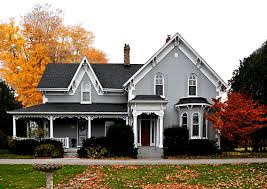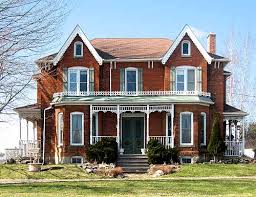
 Victorian-style homes, which were popular during the reign of Queen Victoria (1837-1901), are among the most iconic and recognizable architectural styles in Eastern and Central Ontario. These homes are known for their intricate, ornate details, vibrant colors, and dramatic design elements. Victorian architecture encompasses a variety of sub-styles, including Gothic Revival, Second Empire, Queen Anne, and Italianate, each bringing its own unique features. In Ontario, these homes reflect the prosperity and growth of the region during the late 19th century, particularly in cities like Ottawa, Kingston, and Toronto, where the industrial revolution fueled an architectural boom.
Victorian-style homes, which were popular during the reign of Queen Victoria (1837-1901), are among the most iconic and recognizable architectural styles in Eastern and Central Ontario. These homes are known for their intricate, ornate details, vibrant colors, and dramatic design elements. Victorian architecture encompasses a variety of sub-styles, including Gothic Revival, Second Empire, Queen Anne, and Italianate, each bringing its own unique features. In Ontario, these homes reflect the prosperity and growth of the region during the late 19th century, particularly in cities like Ottawa, Kingston, and Toronto, where the industrial revolution fueled an architectural boom.
Key Features of Victorian-Style Homes in Eastern and Central Ontario:
- Ornate Exterior Details: Victorian homes are renowned for their elaborate and decorative exteriors. Unlike the more restrained and symmetrical designs of earlier architectural styles, Victorian homes are marked by asymmetry, irregular shapes, and intricate detailing. You’ll often find decorative trim around windows and doors, including gingerbread-style carvings, corbels, and spindles. These homes may also feature ornamental patterns on the facade, such as scrollwork, arched windows, and decorative brackets.
- Complex Rooflines: One of the most defining characteristics of Victorian homes is their complex rooflines. The roofs often feature steep gables, turrets, dormers, and other elements that create a multi-faceted, picturesque silhouette. In Ontario, these roofs were designed to shed snow efficiently during harsh winters, and the steepness helps prevent the accumulation of heavy snow and ice. The roofs are often covered with asphalt shingles or slate tiles and may include a combination of dormer windows or towers that add a whimsical, fairy-tale-like quality to the home.
- Bay Windows and Turrets: Many Victorian homes in Ontario, particularly those from the Queen Anne sub-style, feature bay windows that protrude outward, providing more interior space and allowing for panoramic views of the surrounding landscape. Turrets, which are small, tower-like projections from the main structure, are common in these homes and add to the homes’ dramatic, asymmetrical appearance. These elements often make Victorian homes stand out as architectural landmarks in neighborhoods.
- Tall, Narrow Windows: Victorian-style homes often have tall, narrow windows, typically in sets of two or three. These windows may be adorned with shutters or decorative window trim and are arranged in a vertical pattern, adding to the home’s sense of height and elegance. Stained glass is also a common feature, especially in the upper windows or the front door, contributing to the colorful, vibrant look of Victorian homes.
- Wide, Wraparound Porches: Victorian homes often feature expansive front porches that wrap around the front and sometimes even the sides of the house. These porches are supported by decorative columns or spindles and often have intricate railing designs. In Ontario, the large porches were not only aesthetic but also functional, providing shelter from the summer sun and a space to enjoy outdoor living. The design of the porch often complements the overall asymmetrical and ornamental character of the house.
- Decorative Masonry and Materials: In Ontario, Victorian homes were often built using a combination of brick, stone, wood, and sometimes even cast iron. The exteriors are typically painted in rich, vibrant colors, with contrasting trim in different shades. Brick facades may be accented with stone or wood detailing, and the combination of materials is used to highlight the intricate architectural features of the home. The use of locally sourced stone, like limestone, is common in older homes, especially in regions like Kingston or Ottawa.
- Intricate Interior Details: The interiors of Victorian homes are as ornate as the exteriors, with rich woodwork, intricate moldings, and stained-glass windows. Rooms are often divided by decorative wooden archways, and floors are typically made of hardwood or tile with intricate patterns. The walls are sometimes adorned with wallpaper in floral or geometric patterns, contributing to the lush, decorative feel. Victorian homes are also known for having elaborate fireplaces, often surrounded by detailed mantels, which serve as focal points in the living and dining rooms.
- High Ceilings and Spacious Rooms: Victorian homes typically feature high ceilings (often 10 feet or more), which make the rooms feel grand and airy. The large rooms, especially in the main areas of the house such as the living room, dining room, and entryway, are designed to be formal and spacious. The layout often includes a central hallway with rooms branching off to the sides, and many Victorian homes have multiple stories, which adds to the vertical emphasis of the architecture.
- Asymmetry and Irregular Floor Plans: Unlike earlier, more symmetrical styles like Georgian or Colonial, Victorian homes often have asymmetrical facades and irregular floor plans. The exterior walls may feature protruding sections, such as bay windows, towers, and varying rooflines. Inside, the rooms are also less uniform, with each space feeling unique and tailored. This irregularity contributes to the sense of individuality and charm that characterizes Victorian homes.
- Vibrant and Bold Color Schemes: Victorian homes are known for their bold, often contrasting color schemes. They are frequently painted in multiple colors, with the body of the house in one shade and the trim in contrasting or complementary colors. This use of color highlights the ornate detailing and gives the home a playful, lively aesthetic. In Ontario, the Victorian color palette may include deep greens, burgundies, mustard yellows, and browns, which help the house stand out in the natural environment, especially in the autumn months when the surrounding foliage is turning.
Variations of Victorian Style in Eastern and Central Ontario:
- Gothic Revival: The Gothic Revival style, which is part of the larger Victorian umbrella, is sometimes seen in Ontario’s Victorian homes. Characterized by pointed arches, steep roof pitches, and decorative wooden trim, Gothic Revival homes may evoke a more medieval or ecclesiastical feel. These homes were often built using brick or stone, and in Ontario, you’ll find them particularly in rural areas and older urban neighborhoods with historic significance.
- Queen Anne Victorian: The Queen Anne style is one of the most well-known Victorian sub-styles, characterized by its ornate detailing, asymmetrical shapes, and the presence of turrets, bay windows, and wraparound porches. In Ontario, Queen Anne Victorian homes are particularly common in urban areas like Ottawa and Toronto, where they were often built as grand houses for wealthy families during the late 19th century. These homes feature intricate woodwork, brightly colored exteriors, and grand interiors, with large, open spaces and dramatic, high ceilings.
- Second Empire: Another popular Victorian style in Ontario is the Second Empire, which is characterized by a mansard roof, often with dormers, creating a distinct, French-inspired silhouette. These homes typically have a more formal, stately appearance, with detailed cornices, decorative moldings, and expansive windows. Second Empire homes in Ontario are most often found in urban settings, where they were used for government buildings, large residences, and commercial properties during the Victorian era.
- Italianate: Victorian homes in Ontario sometimes exhibit Italianate characteristics, which include low-pitched roofs, wide eaves, and decorative brackets under the eaves. These homes often have tall, narrow windows and are typically made of brick or stone. In urban areas, particularly in cities like Toronto and Kingston, Italianate homes may have been built for middle- to upper-class families during the 19th century.
Conclusion:
Victorian homes in Eastern and Central Ontario are rich in character, elegance, and historical significance. Known for their ornate exteriors, dramatic rooflines, large windows, and intricate details, these homes offer a glimpse into the prosperous and artistic era of the late 19th century. Whether found in urban centers like Ottawa or Kingston, or in historic rural areas, Victorian homes remain a cherished part of Ontario’s architectural heritage, standing as symbols of the past while continuing to captivate homeowners and visitors alike. Their colorful, intricate designs, along with the use of durable materials and thoughtful craftsmanship, ensure that Victorian homes will remain iconic for generations to come.

